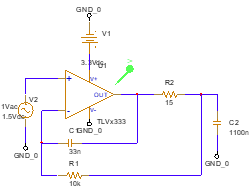Other Parts Discussed in Thread: TLV9004, TLV376
Tool/software:
Hello
I would like to use TLV333 to make a bias voltage and I would like to check the stability. However, when I try to run AC analysis. The simulation almost run out of work.
Could you help me run TINA of the simulation? if it is not stable, could you help adjust the circuit to make it stable?


